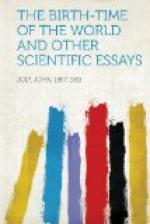20
from minerals of low radioactivity in which the derived lead would be small in amount. By rejecting such results as appeared to be of this character, he arrives at 370 millions of years as the age of the Devonian.
I must now describe a very recent method of estimating the age of the Earth. There are, in certain rock-forming minerals, colour-changes set up by radioactive causes. The minute and curious marks so produced are known as haloes; for they surround, in ringlike forms, minute particles of included substances which contain radioactive elements. It is now well known how these haloes are formed. The particle in the centre of the halo contains uranium or thorium, and, necessarily, along with the parent substance, the various elements derived from it. In the process of transformation giving rise to these several derived substances, atoms of helium—the alpha rays—projected with great velocity into the surrounding mineral, occasion the colour changes referred to. These changes are limited to the distance to which the alpha rays penetrate; hence the halo is a spherical volume surrounding the central substance.[1]
The time required to form a halo could be found if on the one hand we could ascertain the number of alpha rays ejected from the nucleus of the halo in, say, one year, and, on the other, if we determined by experiment just how many alpha rays were required to produce the same
[1] Phil. Mag., March, 1907 and February, 1910; also Bedrock, January, 1913. See Pleochroic Haloes in this volume.
21
amount of colour alteration as we perceive to extend around the nucleus.
The latter estimate is fairly easily and surely made. But to know the number of rays leaving the central particle in unit time we require to know the quantity of radioactive material in the nucleus. This cannot be directly determined. We can only, from known results obtained with larger specimens of just such a mineral substance as composes the nucleus, guess at the amount of uranium, or it may be thorium, which may be present.
This method has been applied to the uranium haloes of the mica of County Carlow.[1] Results for the age of the halo of from 20 to 400 millions of years have been obtained. This mica was probably formed in the granite of Leinster in late Silurian or in Devonian times.
The higher results are probably the least in error, upon the data involved; for the assumption made as to the amount of uranium in the nuclei of the haloes was such as to render the higher results the more reliable.
This method is, of course, a radioactive method, and similar to the method by helium storage, save that it is free of the risk of error by escape of the helium, the effects of which are, as it were, registered at the moment of its production, so that its subsequent escape is of no moment.
[1] Joly and Rutherford, Phil. Mag., April, 1913.




